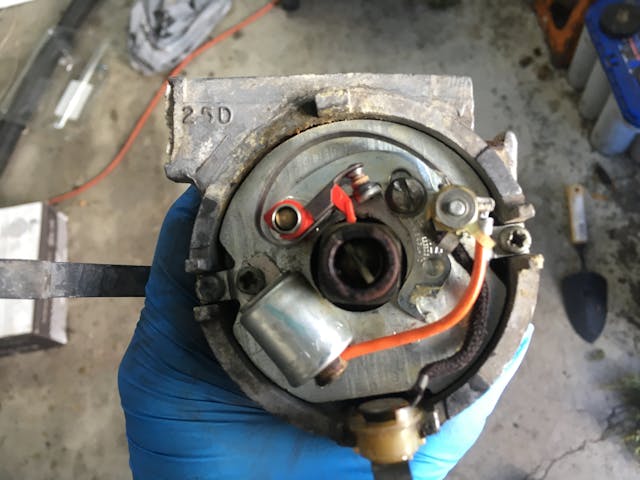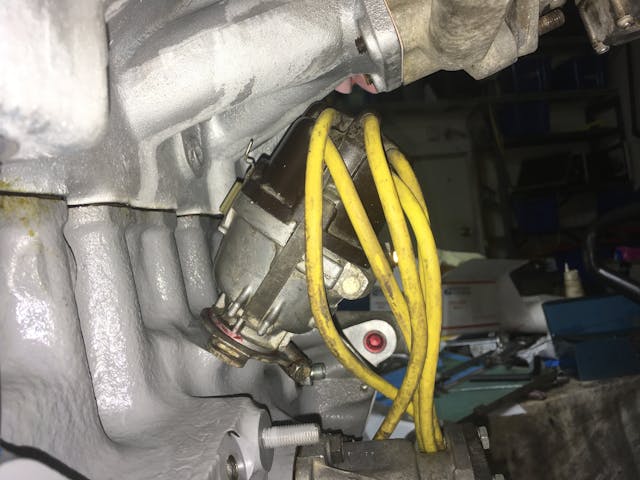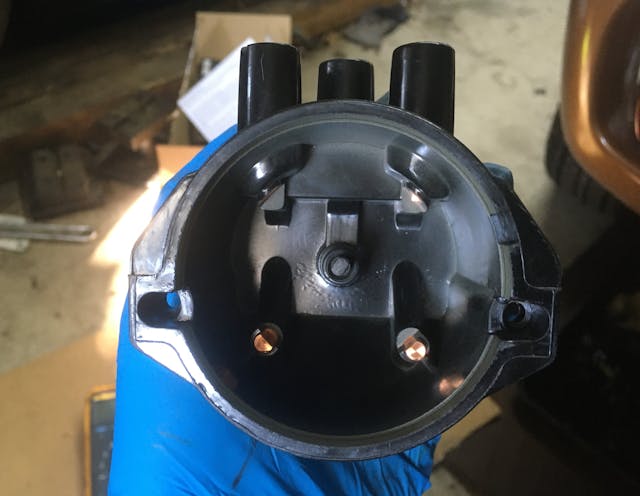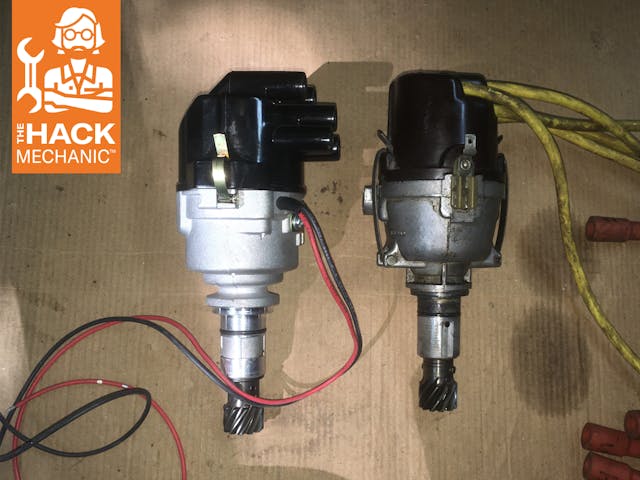Media | Articles
Upgrading the distributor comes with plenty of issues and choices
(First, a quick plug: My new book, The Lotus Chronicles: One man’s sordid tale of passion and madness resurrecting a 40-year-dead Lotus Europa Twin Cam Special, is now available. It’s a deep dive into the passion involved in buying, resurrecting, and owning a car that others might have given up on. You can find more information at the end of this column.)
Speaking of the Lotus, when I finally got its engine rebuilt and installed last spring, I reinstalled its original Lucas distributor, which was still wearing the cap, rotor, plug wires, points, and condenser it had when it was put into storage in 1979. Hey, it functioned, sort of, and at that point there were still so many things on the car that didn’t. However, I just had the opportunity to revisit this, and thought I’d lay it out for you, as it’s a good exposition of the issues and choices involved in upgrading any ignition and distributor.

When you’re sorting out a car, it’s important to verity that the distributor is actually advancing with increasing engine rpm before you try to set the timing. Timing is usually set either statically, by putting a light bulb or a voltmeter across the two terminals of the coil and rotating the distributor so it fires the #1 plug at a certain advance, or dynamically with a timing light while the engine’s running, but if that timing doesn’t change with changing engine rpm—if the distributor doesn’t actually advance the timing as you rev the engine up—your engine will be way down on power and may run hot.
You verify that the advance mechanism is working by painting a timing mark with Wite-Out on the flywheel or front pulley. It’s best if you paint the existing Top Dead Center (TDC) mark so neither you nor a future owner gets confused, but really, any mark will do, because the first thing you need to look for is whether, when you shine the timing light and rev the engine up and down, the mark moves at all. If it does, you then can go ahead and set the timing, but if it doesn’t, the distributor isn’t advancing, which means that the mechanical collection of weights, pivot points, and springs inside isn’t moving freely.

The other thing you may see when you shine the timing light on the painted mark is jitter—the mark jumping around even when you’re not changing the throttle position. This is indicative of the pivot points in the mechanical advance mechanism being sticky. A little jitter is normal in a mechanical advance distributor, but if the mark bounces around so much that you can’t see an average advance value, that’s a problem.
Marketplace
Buy and sell classics with confidence
When I first got the Lotus running, I set the timing statically at 5 degrees before top dead center, like the factory manual says, then I checked for jitter and advance with the timing light, and found—like so many systems on the 40-year-dead car—that it worked far less than optimally. At idle, the timing mark was bouncing all over the place, and when I revved it up, I could sort of see the average value of the mark advance, but the actual amount of advance was clouded in the jitter. Since there were many more-pressing issues needed to make the car road-worthy, the quasi-functional distributor wasn’t the neediest kid in school, so I left it alone and drove it that way.
Fast-forward 18 months. The car is now remarkably well-sorted. I jump in it, fire it up, and pleasure-drive it just about anywhere. With so many layers of the onion now peeled, I decided to re-look at the issue of timing to see if I could eek a little more snap out of the engine when I step on it.
With an old car, you time it by first setting the dwell by tweaking the point gap and verifying the result on a dwell meter, then verifying that the distributor advances with increasing rpm, then setting the timing to factory specs (which is usually a specific advance at a specific engine rpm, like 25 degrees before top dead center at 2700 rpm or whatever is called for on your car). However, with changes in gasoline (lead out, ethanol in), emission controls that may have been removed over the years, possible engine modifications, and a distributor whose advance curve may not be what it once was, the factory setting may no longer be best. The engine may be able to tolerate more advance. Or the factory setting may already be too much.
Basically, what you want to do is adjust the timing, so you never hear the engine ping or knock. Knocking—more accurately, pre-ignition, which is usually described as sounding like marbles loose under the hood—is caused by the timing being advanced far enough that, under load, the mixture is igniting while the piston is still rising in the combustion stroke. It is to be avoided at all costs. If you let an engine go on pinging, it can burn holes in the top of the piston.
The way to time a vintage car is to set it to the factory spec, then fill the tank with fuel of the octane rating you intend to routinely use. If that’s high-test (93 or 94), great, but once you set the timing for high test, don’t cheap out and start running on 87. Then you subject the engine to an extreme load condition, like floored, going up a hill at 40 mph in fifth gear. If you hear it knock or ping, immediately back off the throttle and downshift so it stops. When you get back home (or find a safe parking lot), retard the timing by loosening the bolt at the base of the distributor and turning the body of the distributor just slightly in the same direction the rotor normally spins.
In most engines, the rotor spins clockwise, so to retard the timing, you turn the body of the distributor clockwise as well. Conversely, if the engine doesn’t knock or ping at all under extreme load, the ignition can probably use a little more advance, so you turn the body of the distributor just a skosh in the advance direction, usually counterclockwise, and try the load test again. If the dizzy spins counterclockwise, as it does in my Lotus and did in my Porsche 911SC, you reverse these directions. Once you’ve done this for a while, you learn to find that spot in the timing where you can juuuuuust hear it starting to knock under load conditions that you would never subject it to (I mean, who goes uphill at 40 mph floored in fifth gear, really?). But getting it so it never knocks under any circumstances is safer.
Once you think you have it dialed in, it’s good to measure the total amount of timing advance using an “advance timing light,” which is a timing light into which you can dial in a certain amount of advance and look for the Top Dead Center (TDC) mark. On most vintage cars, the amount of advance maxes out and stays constant over about 4000 rpm, so if you rev the engine up that high and can see the TDC mark when you dial, say, 35 degrees of advance into the light, the timing has been set to 35 degrees of total advance. This is handy because now you can set the timing again to that same amount in your garage rather than having to do it iteratively by flooring the car uphill and then tweaking the timing.

Last week, I began to go through this process with the Lotus. I wanted to see what the current total advance was, so I put the advance timing light on it. I remembered the dizzy being jumpy a year and a half ago, but what I found was worse than I remembered: When I revved it up to measure the total advance, the timing jitter was so great that the TDC mark wouldn’t even stay within the window in the bell housing to take the measurement. Visually it appeared to me that the amount of jitter was about the same as the amount of advance, which means it was pretty bad.
Now, when you find something like this, there are three basic paths you can take. You can take the distributor apart and clean and rebuild it yourself, you can send it out for rebuild, or you can buy a new distributor, but you really need to do something, as that much jitter is certain to affect performance.
Going hand in hand with this is the question of upgrading from points to electronic triggering. As I and others have noted, the quality of new mechanical ignition parts these days is awful, with condensers that don’t properly discharge and points that sometimes snap off the little nylon block that rides on the distributor’s cam lobes, which was why I’d kept the Lotus’ original distributor intact. Everyone’s entitled to their own opinion about this, but I’ve written quite a bit on the whole points versus PerTronix thing (PerTronix being one of several reputable vendors of electronic triggering retrofit modules) and the multiple benefits of switching to electronic triggering. Some folks insist that triggering modules are failure-prone black boxes. I’ve only had them fail when I’ve installed them wrong. Many folks who have them admit that they keep a set of points and a condenser in the trunk in case the triggering module does fail. That’s fine for most cars, where you can easily swap the original components back in without even removing the distributor, but with the distributor on the Lotus being hidden under the intake manifold, I wanted a high-reliability setup, at least higher than running on 40-year-old ignition components.

There are basically three options here as well. You can simply replace the points and condenser with an electronic triggering module, you can purchase a new distributor that has the module already fitted, or you can buy one of the whiz-bang distributors from 123 Ignition that not only has electronic triggering, but also programmable electronic advance as well (no more springs and weights, and the ability to upload your own custom advance curves).
In my case, since what was driving my purchase was a massively jittery distributor, and since I didn’t want to blow precious fall driving weeks waiting for a rebuild, I opted to kill two birds with one dizzy and replace it with a new one that had electronic triggering already installed. At the high end, the Bluetooth-programmable unit from 123 Ignition is a stiff $530. At the low end, I found a distributor from Accuspark, along with a coil, being sold by a British company for about $150, but the reviews on British car forums were mixed.
In the middle, I learned that PerTronix offers a new distributor for the Lotus Twin Cam and the Ford Kent Crossflow engine. I found a vendor selling it, along with a matched PerTronix “Flame-Thrower II” ignition coil (with any electronic triggering module, you need to be very careful that the resistance of the coil falls within their recommended range) for $280 shipped. I’ve always been circumspect about anyone’s “hotter spark” claims, but I’ve had good luck with PerTronix products over the years, and the reviews of the PerTronix distributor and matched coil on the Lotus forums were excellent. I clicked and bought, and the parts arrived a few days later.

I laid up the Lotus in the garage, rotated the engine to the TDC mark, and pulled out the original Lucas distributor. As I said, the dizzy in the Lotus is under the intake manifold, is a bit of a pain to access, and has an angled cap with the plug wires coming in at a 90-degree angle, so when you replace it, you need to index it correctly so the cap points to the left.

I unpacked the new PerTronix distributor and pulled off its angled cap so I could position the rotor at the mark on the rim for #1 cylinder and was quite surprised to find that there was no mark on the rim for #1 cylinder.

On most cars, this wouldn’t be a big deal, as you can plainly see where the terminal on the cap is for the #1 plug wire, mark that location on the dizzy, and just look straight down at the dizzy to line the rotor up on the mark when you put it in, but the combination of the angled cap and the occluded view beneath the intake manifold made this difficult.

I thought that I’d just time it statically as I originally did, but when I put the test light across the two terminals of the coil, it never lit, despite my rotating the dizzy over 90 degrees. Initially I was mystified by this, but reading online, I learned that you can’t statically time an electronic triggering unit that uses a Hall Effect sensor like the PerTronix, as the little magnets need to be whizzing past the sensor in order to generate the trigger that fires the coil, which makes perfect sense.
Next I thought that I’d simply use my multimeter to verify when the center terminal on the cap and the socket for #1 plug wire were in contact, but that didn’t work either, I assume because the rotor doesn’t actually touch the inside of the cap—the spark jumps a tiny gap between it and the terminals.
Finally I just wrapped some tape around the tip of the rotor, eyeballed it between #1 and #2 terminals, put the cap on, rotated the dizzy by hand until I felt the resistance of the taped rotor hitting the side of the #1 terminal on the inside of the cap, pulled the cap and the tape off, and marked the body of the dizzy at that location.
I installed the dizzy, trying my best to index it so the rotor pointed to the mark I just made, even though I couldn’t look straight down on it due to it being blocked by the intake manifold. I mounted the new “Flame-Thrower” coil, taking care to be certain it was wired correctly to the new dizzy. I double-checked everything, pulled the choke, and turned the key. The car refused to start.
I hooked up a remote start switch, pulled the coil wire from the center of the dizzy, held it a quarter inch from ground, and cranked the engine to check for spark. Not only was it bright, but it zapped my hand good, even through the nitrile gloves I was wearing. Wow, I thought, I guess this really is a hotter spark. I then repeated the test at the plug wires to verify the spark was actually reaching the plugs.
I checked everything again, decided that despite my careful marking of the #1 terminal location it was probably off, and just kept twisting the body of the distributor to the right to advance the timing until I heard it burble, then start. Once I had it running and it warmed up, I connected the advance timing light, delighted at the fact that the TDC mark now stayed in one place for a given throttle setting, set the total advance to 30 degrees—a number that multiple posters on Lotus forums reported as a reasonable value—and took it for a short test drive.
Wow. Even without further advance-it-’til-it-pings tweaking, there’s a snap and a solidity to it, particularly winding it through the mid-rpm range where I can actually feel it advance like it’s supposed to.
Now, I should say that, in general, electronic triggering by itself should not be thought of as a performance improvement. It’s really not. It’s a reliability and maintenance improvement. But having a distributor that actually advances without drifting around by an amount equal to the advance, THAT’s a performance improvement. I’m sure the stronger spark helps, though I can’t quantify by how much. The whole issue of wringing performance out of the advance curve itself, optimizing it for your particular car, I believe can only be quantified on a dynamometer.
In conclusion, for most people owning a vintage car, if you get it to the point where: A) you verify that it advances with increasing engine rpm, B) there’s not a lot of visible timing jitter, and C) it’s timed to spec, advanced slightly to the point of knocking under ridiculous load conditions, and backed off, you and it are in a good place. If the distributor is new or newly rebuilt by someone reputable so the advance curve is what it should be, so much the better. If, on top of all that, you don’t worry about the ignition dying, either because you’ve bought a reputable electronic triggering module or you have a secret stash of new old stock points and condensers, you should be smiling. I know I am.
Go forth and advance and trigger yourselves as you see fit.
***
Rob Siegel has been writing a column (The Hack Mechanic™) for BMW CCA Roundel magazine for 34 years and is the author of seven automotive books. His new book, The Lotus Chronicles: One man’s sordid tale of passion and madness resurrecting a 40-year-dead Lotus Europa Twin Cam Special, is now available on Amazon (as are his other books), or you can order personally-inscribed copies from Rob’s website, robsiegel.com. For more information about vintage ignition systems, see Mechanical Ignition Handbook: The Hack Mechanictm Guide to Vintage Ignition Systems from Bentley Publishers.


















